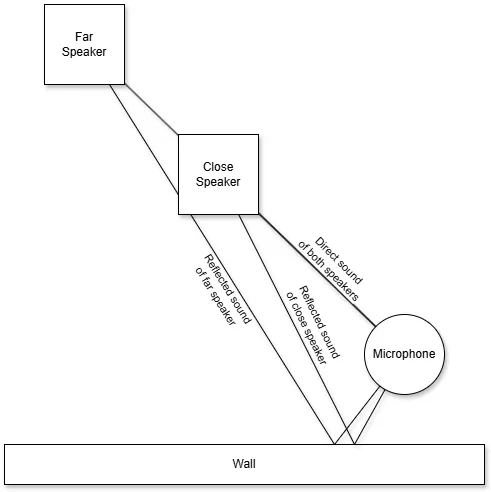Learn interpreting audio measurements with Cavern
How to place measurement microphones
Positioning a measurement microphone can make or break a measurement. Using a single point, the measured spot could drastically differ even at a hand's distance. Single point measurements are not recommended, but if it's the only option because of time or cable constraints, the best position is where the listener's head could be:

At 3 positions, we can start to account for bass. Bass takes the most drastic change between measurement positions, and can get cancelled on any plane completely. To prevent measuring a cancellation on any plane, we need to measure at least two positions on the left-right, forward-backward, and up-down axis. Good bass is also more felt than heard, so we need to account for the full body. Knowing this, and that the treble is way less chaotic across the room, lower positions start to get more significant. Good candidates for such positions are the armrests. For these reasons, the best results from 3 measurement positions usually come from the following 1 headrest 2 armrest setup:

As the measurement positions increase, add 2 more headrest positions, then 2 more armrest positions, then 2 more headrests, then 2 more armrests, and so on. For 5 measurement positions, it looks like this:

This technique is best used in expensive or commercial theaters because of the number of armrests. If you're out of armrests, use random placements, but adhere to these rules:
- Move around on all axis, including width, height, and depth.
- Measure as wide as the listening space, go to the sides of the seats or couch, but no further.
- Don't measure too close to a previous position.
- Make sure the microphone is always in direct line of sight from tweeters.
- Try not to measure at even division points of each axis (1/2, 1/3, 1/4, etc.), but this isn't as important as the others.
What if the couch is on the wall?
It's a common fear that measuring close to the wall might yield poor measurement results. This fear might originate from how the sound of speakers worsen when they are close to walls. Yes, the sound of a theater close to its walls can get drastically distorted compared to other parts of the room, but if listeners sit there, we have to measure what they hear. Just like the microphone, listeners on a couch that's pushed to the wall will hear the same distortions the microphone picks up. This means if the headrest of a theater's single couch is by the wall, we have to measure by the wall.
The root of distortion
The main reason of the sound discrepancies by walls is because of a single phenomenon: reverberated sounds bouncing from the wall arrive later to the microphone than the direct sound. The result in a perfect example, where only a single wall is present, would be notches in the spectrum at equal intervals. Thankfully in this case, rooms are never perfect examples, and other reverberations taking different paths generally fill in these gaps. The entire effect is dependent on too many variables, not just on the angle of the speaker, but at the same angle, even on the distance of the speaker:

On this example, the direct path from the close speaker is 258 cm, while the reflected sound takes 486 cm. This is a 228 cm surplus. For the far speaker, the direct sound takes 445 cm to arrive, the reflection takes 660 cm. This is only a 215 cm surplus, a 6% difference from the closer speaker. And this is just a single factor. These add up, resulting in a distortion so complex we'd have to calculate for hours with simulations, so we just don't. But we have some generally true statements we can work with. First:
This is only an advertisement and keeps Cavern free.
Bass at the walls
Bass is heavily amplified at walls, this is why we put weak subwoofers by walls or even by two walls in a corner. This can happen, because bass waves, thanks to their longer wavelengths, have no space to meaningfully interfere with each other. The further you go from a wall, the lower the first frequency where distortions start. Close to the walls, because of less cancellations, listeners generally hear drastically increased bass. This is very apparent on the following measurements at a speaker directly in front of the listener, and another one directly to the side.
| On-axis (0°) | Side (90°) |
|---|
In these cases, we see the bass of the mic closer to the wall near-perfectly following the microphone placed at the listener's ear. This is always true for bass, but in the side speaker case, it also helped the mic near the wall to get drastically closer to the correct measurement at the 1000-3000 Hz range. Bass is so accurate on these graphs, because a human head is not much of an obstacle for low frequency sound waves, while it is for high frequencies.
Treble at the walls
This is where problems seem to appear. Let's look at the same room, now with a third speaker:
While in this case, bass is still perfectly following what the listener hears, but after about 500 Hz, the first dip begins to appear, with a second following closely. This is indeed caused by the near-comb filter effect discussed in The root of distortion section. However, let's look at the previous measurements: those are better at the entire range, so what do we do now? We average. A lot. Because the distortions are practically random, they cancel out, given enough positions. Some positions get closer to the listener's experience, some get further away from it. On average, the positions will match the distant-from-wall measurements, while providing drastically better results on the low end. Measuring at least 5 positions, even for a single listener, is heavily recommended.